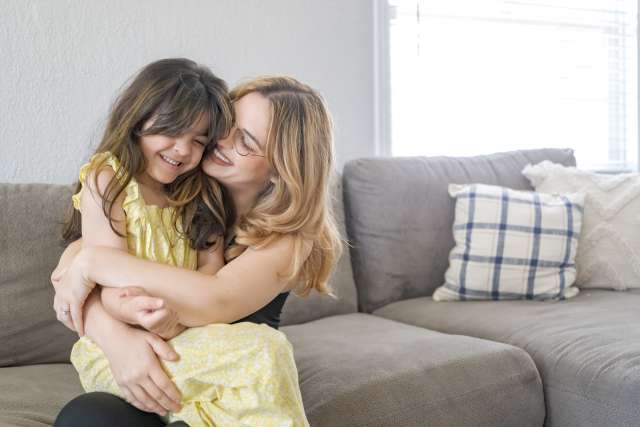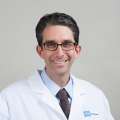It started with a bad cold.
It was December of 2022, and 4-year-old Raylee Osuna had a cough, stuffy nose and a slight fever. Even though she seemed better after a few days, her mom, Klarissa Hope, had a sense that something was still off.
Several weeks later and despite several medical appointments, Raylee still hadn’t fully bounced back. On Christmas morning, she looked pale, and Hope brought her to Urgent Care near their home in Ontario to request that bloodwork and other tests be done.
At that point, none of Raylee’s results showed any cause for concern. “They all kept telling me it was just a virus,” Hope said.
By then, it was early January. The family was at Denny’s, Raylee’s favorite restaurant, and Raylee put her head down on the table and told her mother she didn’t feel well. And she wasn’t eating – highly uncharacteristic for her, Hope noted.
At yet another medical appointment, the doctor assured Hope that Raylee was just constipated. But then, a few days later, Hope noticed that Raylee’s eyes had started to have a slight yellowish tinge. “It was subtle,” she recalled. “No one would have been able to tell if I hadn’t noticed it.”
The next day, she took Raylee for another appointment, and this time the doctor ordered a test of her liver function, which showed that her enzyme levels were extremely high. Mother and daughter were sent home again, with instructions for Hope to continue to monitor her. Raylee’s elevated levels were likely due to residual inflammation from the virus, Hope was told, but her liver would likely recover on its own.
Instead, everything spiraled downward.
That night, Raylee was restless in bed and moaning in her sleep. Trying not to panic, Hope and her husband, Gilbert Osuna, debated about whether to wait until morning to bring her in. By now, it was 1 a.m., but they decided to bring Raylee to the local emergency department rather than wait any longer.
There were no pediatric emergency beds available, which meant Raylee needed to be transferred to a different facility. Hope asked to have her brought to Children’s Hospital of Orange County (CHOC). “I figured, let’s go somewhere that specializes in children,” she said.
Quickly decompensating
Raylee was transferred by ambulance to CHOC. Again, Hope and her husband were told that the liver usually recovers on its own.
But in Raylee’s case, that wasn’t happening. The medical staff at CHOC soon recommended that she be moved to UCLA Mattel Children’s Hospital.
There, Hope and her husband were shocked to learn that it was time for a back-up plan: adding Raylee to the transplant list in case she ended up needing a new liver. Pediatric gastroenterologist , MD, described it to Hope as a safety net in the event Raylee’s liver didn’t recover.
“We were freaking out,” Hope said. “What do you mean, transplant? He was super comforting and nurturing. He acknowledged we were scared for our daughter’s life and told us we’d come to the right place.”
Raylee was acting fine at this point, but her skin was starting to appear yellow, and the yellowish tinge in her eyes was becoming more prominent – both signs of increasing bilirubin, indicating that her liver was continuing to decline.
Meanwhile, other waste products, such as ammonia, were building up as her liver struggled to function.
“One of the functions of the liver is to clean your blood from toxins,” explained , MD, director of the UCLA Liver Transplant Program. “The kidneys do this to some degree as well, but they don’t clear ammonia – the liver does this. When these toxins accumulate, they affect \your state of consciousness and brain function.”
UCLA Health specialists have performed more than 1,000 children’s liver transplants.
Learn more about UCLA Health's Pediatric Liver Transplant Program(Link opens in new window)
The condition, called hepatic encephalopathy, was yet another danger sign.
“Her ammonia levels caused her to go crazy,” Hope said. “She was screaming bloody murder, like someone was hurting her. She was hitting me and kicking me.” Even as Hope and the nurses tried to calm her down, Raylee was running around the room, jumping on the bed, stiffening up, and behaving “like a zombie,” Hope recalled.
The episodes would last for about 10 minutes and then subside, but Raylee was increasingly lethargic the rest of the time. She was taken to a procedure room to be intubated and heavily medicated.
“It was like my heart was pulled out,” Hope recalled. Raylee was no longer conscious, but Hope and her husband stayed with her to rub her feet and hands and help counteract the swelling and stiffness starting to set in.
As her liver continued to fail, her kidneys did too. A couple of days later, Raylee was put on dialysis to keep her alive while the urgent search for a donor liver continued.
Splitting a donor liver to create the right match
“They told us ‘It has to be a perfect liver – she’s a young little girl,’” Hope recalled.
And then, that afternoon, she and her husband received the news that a potential match had been found. “The liver came at the perfect time,” Hope said. “If it didn’t, I don’t think Raylee would be here today.”
Dr. Kaldas headed out to perform the surgery, to obtain the liver from the deceased adult donor and split it into two parts: one for Raylee, and one for another patient at UCLA Health. The smaller part would be for Raylee, given her size.
“The liver is the only organ in the body that can grow again,” Dr. Kaldas explained. “And that really is the only reason we’re able to split it in this manner.”
The procedure, called an in-situ split, is a unique strength that not every transplant program has, he said. “This was not a bread-and-butter pediatric liver transplant. To be able to split the liver and bring it back and use it for her – an extraordinarily sick child – it’s a complex operation that not every program can do.”
While the in-situ split was taking place, the UCLA Health team and Raylee’s parents concentrated on keeping her alive.
“We were cracking open warming packs and putting them on Raylee’s body to keep her warm so her heart rate would go back up,” Hope said. “She had at least 60 heating pads on her. And when they’d cool off, we’d crack more open and replace them. They’d approved the liver in the middle of the night, and we were just trying to keep her alive until the surgery.”
Once morning came, Raylee was wheeled into the operating room for the initial surgery.
“When a child is this sick, you want to provide them with a working liver as soon as possible,” Dr. Kaldas explained.
That meant Dr. Kaldas first had to remove Raylee’s native liver and implant the new one by connecting it to her body’s blood vessels, letting it kick in, and then doing a second, more minor surgery to connect the bile ducts once the inflammation and acute symptoms subsided. In the interim, Raylee’s incision was temporarily closed and she remained sedated.
Then came the long wait after the second surgery for Raylee to wake up. One day passed, then two. “They were starting to think she might have brain damage,” Hope said.
And then, finally, she opened her eyes. “They weren’t yellow anymore; her scalp had even been yellow and wasn’t anymore,” she said. “Finally, all of it was done – it was just like a miracle.”
Feb. 9, 2023, about two months from when she’d first come down with a cold, Raylee finally got to go home.
Returning to normalcy
Since then, there have been some minor complications, including scar tissue build-up in the bile ducts that required a temporary stent and then a bile bag. Raylee wore the bile bag all last summer, allowing bile to drain externally while the stents allowed the ducts to remain open and heal.
In addition to monthly appointments and labwork at UCLA Health, Raylee has monthly antibody infusions – two five-hour sessions on subsequent days – done at a local facility. She also takes several medications in the morning and at night.

Because of her health situation, Raylee, is enrolled in kindergarten through her local district but learns at home, where she’s visited daily by a teacher.
Her older brother, who’s now 11, is also now doing independent study, given the upheaval of frequently missing school during Raylee’s medical journey. Raylee’s other sibling, now 2, was just 7 months old during Raylee’s hospitalization. “I didn’t see them for over a month straight,” Hope recalled. Although they were in good hands with other family members, “it really affected all of us.”
Now, though, if you looked at Raylee, “you wouldn’t think she’d been through any of that,” Hope said. “She’s brave – she’s a warrior and doesn’t complain about anything.”
Raylee, who recently turned 6, has also maintained a bond with Dr. Kaldas.
“She calls him ‘Freddie,” Hope said. “We send him updates and pictures constantly.”
Dr. Kaldas also makes an effort to stay in touch with Raylee’s family. “If I don’t hear from them for a while, I’ll check in to see how Raylee’s doing,” he said. “It makes my day to see her doing well. She’s the cutest child. It is a true privilege to see her living and enjoying life normally and fully. That is what liver transplantation is all about.”


